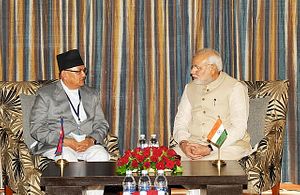India’s “unofficial” blockade of goods on its side of the Nepal border would seem to be a successful flexing of New Delhi’s muscles to its neighor. However, this punishing of Nepal for not addressing India’s concerns in its new constitution appears to be the first act in a diplomatic suicide.
Nepal’s border with India has been blocked for more than two months, and is being referred to as another “disaster” following the April 25 earthquake, which killed more than 10,000 people and destroyed hundreds of thousands of houses. The blockade has choked imports of not only petroleum, but also medicines and earthquake relief material.
New Delhi has blamed the blockade on violent protests by Nepal’s ethnic Madhesi activists over their displeasure with federal boundaries and representation in parliament and public office, as provided for in the new constitution. The Madhesh region in southern Nepal is home to people of Indian origin, many of whom still have relatives and friends across the border in India.
New Delhi had told Kathmandu, through a leaked document, that it wanted Nepal’s constitution to address the concerns of the Madhesi people. India was also hoping that Nepal would either be reinstated as a Hindu nation or drop the word “secular” from its charter. But Nepal’s lawmakers didn’t oblige, and believe they are now being disciplined by “big brother.”
The blockade is fuelling anti-India sentiment across the country, barring Madhesh. This growing aversion to India is not just a social phenomenon, it is also becoming a political reality.
Friends, Foes
Before the blockade, two of Nepal’s largest parties – the Nepali Congress and the Communist Party of Nepal (Unified Marxist–Leninist) – were widely seen as sympathetic to India’s interests. In the current Constituent Assembly, the two parties together have 371 of the 601 seats. Today, the two are not counted among India’s friends. Meanwhile, the Unified Communist Party of Nepal (Maoist), which has 80 parliamentary seats, was never pro-India. The Rashtriya Prajatantra Party-Nepal, a right-wing Hindu party with 24 seats, which unsuccessfully demanded that the country be reinstated as a Hindu nation – echoing the desire of India’s ruling Bharatiya Janata Party – has publicly criticized New Delhi after the blockade.
The math is simple, at least 475 of the 601 Nepal’s lawmakers agree with a hashtag that has trended in their country, “back off India.”
Parties in India’s favor include the Terai Madhes Democratic Party with 11 seats, the Federal Socialist Forum-Nepal with 15 seats, the Sadbhawana Party with 6 seats, and the Terai Madhes Sadbhawana Party-Nepal with 3 seats, among a few other small parties.
This should be a serious concern for India.
India’s Role
New Delhi has long enjoyed tremendous influence in Nepal, not just because of the latter’s economic dependence, but more importantly because of the numerous influential local friends New Delhi had cultivated over the last few decades. It was said – until recently and privately – that Nepal doesn’t take any significant political decision without India’s approval.
Like regional powers elsewhere in the world, India apparently exploited local disputes to achieve its diplomatic goals with the help of its local friends, who do not necessarily hurt their own nation’s interests but willingly receive foreign help in matters that can be of mutual gain.
It was no coincidence that whoever – be it King Gyanendra or Maoist leader Prachanda – sought to counterbalance India’s influence in Nepal with that of China, lost power.
It’s common knowledge that Nepal’s political parties, including the Maoists, had Indian help in abolishing the monarchy in 2006. King Gyanendra allegedly sought China’s help in taking in fighting the Maoist, who waged a civil war against the monarchy. It is also widely believed that Prachanda had to resign as prime minister in May 2009 because then President Dr. Ram Baran Yadav, a leader of the Nepali Congress, took a stand against Prachanda in his conflict with the then army chief. Prachanda’s mistake was that he visited Beijing before paying a visit to New Delhi.
A more suitable example could be the 1989 blockade imposed by then Indian Prime Minister Rajiv Gandhi, supposedly due to Kathmandu’s growing closeness with China, as was seen in Nepal’s procurement of Chinese anti-aircraft guns at the time. As a result, New Delhi managed to persuade Nepal to drop the party-less panchayat system, paving the way for political parties-led governance, though still under the monarchy. The people of Nepal were also against the panchayat system, and, more importantly, the Nepali Congress led the movement for the new political system, which was more reassuring to New Delhi.
A New Policy?
However, the political circumstances in Nepal have now changed. The sense of sovereignty among the people and political leaders has naturally increased, now that Nepal has a constitution.
Moreover, it’s only Madhesi leaders who are calling for a constitutional amendment. The Nepali Congress and the Marxist-Leninist party – both of which were seen as pro-India until the blockade – agreed to the provisions of the constitution, or perhaps they had no other option given that there were deep ideological divisions in the Constituent Assembly and the new charter emerged from trade-offs between parties.
If we give the benefit of the doubt to the Indian government led by Prime Minister Narendra Modi, New Delhi may have had reason to react. Perhaps Modi’s government kept its promise, namely that it would not seek to micro-manage Nepal’s internal affairs. However, Modi remains as adamant in achieving India’s diplomatic goals as his predecessors. So the message that the blockade has sent to Nepal is, “We won’t interfere as long as you do what we say.” It is a message that hasn’t gone well with Nepal’s leaders.
India now may revert to its older ways of seeking to play a behind-the-scenes role in securing its interests in Nepal. But the problem is, New Delhi has few friends left to help with the meddling.

































